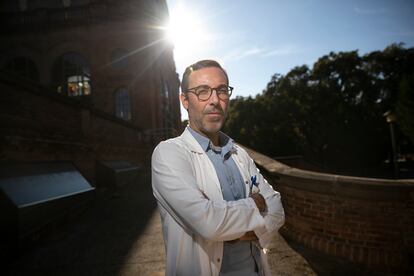Saul Martínez-Horta: ‘I haven’t come across any paranormal phenomena that cannot be explained by a damaged brain’
In a new book, the Barcelona-based neuropsychologist unravels the strange behaviors and conduct that neurological diseases can cause in people

Sometimes, the neuropsychologist Saul Martínez-Horta instructs his patients to draw a clock. “It seems silly,” he admits. But beyond producing a circle that should contain 12 numbers placed around it along with hands marking the time, the exercise is “a display of very elementary cognitive processes,” such as planning, order, sequence, spatial processing... Seeing how a patient draws that simple sketch – and whether he or she can do it - gives this specialist key information about how the patient’s brain works and, most importantly, whether something is wrong.
Martínez-Horta, 41, who works at the Department of Neurology at Sant Pau Hospital in Barcelona, Spain, thoroughly scrutinizes his patients’ gestures, words and behaviors. Any activity can provide a hint of brain processes gone awry or help discover hidden neurological diseases, such as the ones Martínez-Horta describes in his book Cerebros Rotos [or Broken Brains]. His compilation of clinical cases recalls the neurologist Oliver Sacks’ classic The Man Who Mistook His Wife for a Hat. The Spanish neuropsychologist says he was inspired to write the book by the response he got from his Twitter threads discussing the typical cases he sees in therapy. “I think everyone is fascinated about what happens when the brain is damaged,” reflects Martínez-Horta, who now has nearly 40,000 Twitter followers.
Question: How far can a damaged brain go?
Answer. As far as anyone can imagine. The day I realized that brain diseases could possibly explain everything you can imagine happening to a human being, from the most normal things to the most bizarre, I said: this is fascinating.
Q. Can damaged brains be fixed?
A. Some of them can. When a brain stops working as it should, it is not always the consequence of an inevitably progressive disease. It can also be due to intoxication, cancer-related diseases, metabolic ailments... And if you diagnose it, discover what is going on and treat it, you can repair it. That’s why it’s important not to take everything for granted and get to the bottom of it, because some damaged brains can be repaired.
Q. You explain that memory can play tricks on us because it is “an active encoding process,” a transformation of information that was once an experience. Is memory a lie?
A. But what is a lie and what is the truth? We do not have any evidence to suggest that the reality we experience – the reality you experience and the one I experience – is the same. We know that the reality you perceive is what is the most probable, the most plausible, according to your brain’s way of thinking. The brain is constantly anticipating things; it is interpreting the world, not analyzing it, because [otherwise] it would get overloaded; the [brain] uses previous knowledge to anticipate it [instead]. That’s why storing memories isn’t like storing a photo, which I [can] keep in a drawer and take out one day. It’s not like that. The brain transforms an experience into a code and distributes it in different areas of the brain. When we try to retrieve the information through the act of remembering, it has to be reintegrated and the brain uses probabilities, what is most plausible, [to do that], resulting in the transformation of the information. These transformations are normal. Although it is very hard for people to accept, most of our memories are not exact replicas of what we experienced. And that is normal. But with certain diseases, that transformation becomes extraordinarily pathological, although it is experienced as real. That’s what we call confabulation.

Q. Why do we remember certain things but not others?
A. The brain tends to prioritize certain things. When it comes to memory and memory formation, attention is a key factor: the depth with which you process the information you pay attention to correlates with the quality of your memory of it. A very common complaint is: “I am so forgetful lately.” But it’s not that you forget; you just don’t apprehend it [in the first place] because you aren’t paying attention, because you are overwhelmed, tired... On the other hand, because of how memory works, certain aspects of a context make it easier to learn and remember information: emotional information is the typical example because the brain prioritizes everything it associates with signals that are important for survival. The classic example is that everyone remembers what they were doing [on September 11, 2001] when the Twin Towers were brought down: the context’s high emotional impact means that we can remember everything perfectly.
Q. In the book, you argue against normalizing memory loss and other cognitive problems as inherent to aging. But aging leads to cognitive decline. How do you distinguish between the two?
A. There is this idea that senile dementia is inevitable. But that is incorrect. Senile dementia does not exist. Aging does not mean dementia. Dementia is a disease in which the cognitive impairment occurs to such a degree that the person can no longer survive on their own. Someone who gets dementia as they grow older has an associated degenerative disease or some other process [at work]. Indeed, getting older means losing skills that we have acquired or developed, and it also impacts how we function cognitively. But there’s a curve of normality, normal limits. Is it normal to stumble more as we get older? I suppose so. Is it normal to constantly fall on the ground? No. Is it normal to be slower and not as cognitively agile? Yes. Is it normal to repeatedly forget things and have difficulty recalling words? No. When we don’t think of these problems as normal, the next step is to seek help. We should have a little bit of that intuition without becoming hypochondriacs either.
Q. You also say that the brain always prioritizes fear. Why does that happen?
A. Fear is a very primitive emotion, and it is designed to help us survive. In the brain, when the systems that control fear are put into action, they override the expression of all other processes. For example, the way the brain is organized means that when these structures that govern fear are activated, areas that have evolved to be much more modern, such as the ones we use for abstract reasoning or language, function much less well. In fact, a person who is frightened has trouble speaking. And that happens because when we’re facing danger, it may be more useful to not think and [just] act versus thinking and wasting time making decisions.
Q. When you are afraid, you can’t think straight.
A. Exactly. And there are a host of mental health disorders related to expressing fear in a context in which nothing [frightening] is happening. That is typical of anxiety disorders: a person experiences the horrible fear of a situation in which, in principle, there is no danger, and s/he cannot manage that cognitively. The brain is experiencing that moment as a serious danger.
Q. Emotions can be lost?
A. Yes. It’s like any other process. We are the result of what the brain does, and when its parts are failing, anything that depends on it can [also] fail. There are many situations in which, sometimes, a disease’s first symptom is that it completely transforms how a person experiences emotions.
Q. In the book, you explain and label apparitions, ghosts and supernatural events. Can a damaged brain explain all these paranormal phenomena?
A. To date, I haven’t come across any such phenomena that cannot be explained by a damaged brain. When I was a kid, one of the things that most interested me about the world of neuropsychology, about brain damage, was that it could explain paranormal phenomena. If you asked me how many paranormal experiences I have seen with my patients, I would tell you that I think I have [seen] every one in the book. A phenomenon that stems from a damaged brain gives rise to a series of sensations that are what people describe as paranormal.
Q. In your book, when describing the pareidolia phenomenon, for example, you break down the famous Bélmez faces [in 1971, residents of a house in southern Spain claimed that images of faces had appeared on the floor].
A. Yes. Pareidolia is seeing familiar shapes, especially faces, in objects where there aren’t any. The human brain has a region called the facial fusiform gyrus. It is in the lower part of the temporal lobe, which is an area that evolved in humans strictly to process faces. Pareidolia occurs when, because of the ways in which certain visual stimuli are configured, the fusiform gyrus is activated – without you being able to control it – and triggers the perception of a face. This process is unique: you can induce [the faces] by giving [someone] information and after that you cannot go back; that is, if I tell you that there’s a face on the floor and I show it to you, you will not be able to stop seeing the face. The Bélmez faces and apparitions of the Virgin Mary on pieces of toast are examples of that.
Q. And what about déjà vu, the feeling of having previously experienced something that is happening in the present? Does it have a neuroscientific explanation?
A. It has to do with updating memory, which has a temporal gradient: memories have an implicit position in time; I know that my memories of today are from today and not from yesterday. But in cases of déjà vu, for some reason there seems to be a lack of synchronization in this updating process, and the experience in the present is labeled as if it were another moment in time.
Q. Is there anything that neuroscience cannot explain or does not understand?
A. We still don’t fully understand how some things happen, but we don’t have to go to the paranormal [for that]. Take consciousness, for example: it is an attribute that comes from the functioning brain, but we haven’t figured out how the organ and its biochemistry give rise to the phenomenon that allows you and me to be conscious right now. That seems much more complex to me than trying to explain any kind of paranormal phenomenon; I maintain that all paranormal phenomena can either be clearly explained – and, I would argue, even caused – by neurobiology, or they give us a theoretical model for understanding why they happen based on our knowledge of the brain.
Q. In your book, you talk about a man who tried to kill his wife. In that case, he had a neurological problem, but how do you explain evil and violence in general?
A. Violence and evil are multifactorial; there are many variables that come into play when explaining acts of profound evil or violence. Now, in the context of certain diseases, extreme or disturbed violence is a central element of the disease [itself]. One of the frontal lobe’s main functions is self-regulation: [we have] the capacity for self-control and [can] adapt our behavior to an environment’s needs or demands; in addition, we base our behavior on our impression of how the other person feels. We have empathy. In diseases where certain regions of the frontal lobe are not working properly, there may be persistent or occasional behavior of extreme violence. As a neuropsychologist, I believe that it is worth thoroughly exploring the origins of violence or evil when it’s right before our eyes, although we cannot ignore the fact that evil can also be inherent in some people. It’s not about exculpating someone or looking for a coherent explanation but rather bringing what we know about the brain to bear on all human behavior.
Q. But can that always be explained by a neurological problem?
A. Without denying context’s crucial role in all of this, from my perspective as a neuropsychologist with a background in biological behavior, I find it very difficult not to conceptualize the extreme acts of violence or extreme evil that we all see in the news as something dysfunctional that occurred at that moment. That person is not sick, but something has malfunctioned. That is, based on our models of how the human mind works and how it translates into behavior, at that time something in [the person’s] mind is not working the way it should be. But that doesn’t mean that it should not be punishable behavior.
Tu suscripción se está usando en otro dispositivo
¿Quieres añadir otro usuario a tu suscripción?
Si continúas leyendo en este dispositivo, no se podrá leer en el otro.
FlechaTu suscripción se está usando en otro dispositivo y solo puedes acceder a EL PAÍS desde un dispositivo a la vez.
Si quieres compartir tu cuenta, cambia tu suscripción a la modalidad Premium, así podrás añadir otro usuario. Cada uno accederá con su propia cuenta de email, lo que os permitirá personalizar vuestra experiencia en EL PAÍS.
¿Tienes una suscripción de empresa? Accede aquí para contratar más cuentas.
En el caso de no saber quién está usando tu cuenta, te recomendamos cambiar tu contraseña aquí.
Si decides continuar compartiendo tu cuenta, este mensaje se mostrará en tu dispositivo y en el de la otra persona que está usando tu cuenta de forma indefinida, afectando a tu experiencia de lectura. Puedes consultar aquí los términos y condiciones de la suscripción digital.
More information
Archived In
Últimas noticias
Susan Boyle prepares a comeback just as Timothée Chalamet sings her praises
Trump suspends green card visa lottery after shooting at Brown University
When things get out of hand at the lab: Hundreds of accidents expose the ‘catastrophic’ risk of dangerous pathogen leaks
Venezuelan migrants contribute billions of dollars to Latin America, but continue to work in the informal sector
Most viewed
- Christian Louboutin: ‘Young people don’t want to be like their parents. And if their parents wear sneakers, they’re going to look for something else’
- Cartels in Mexico take a leap forward with narco-drones: ‘It is criminal groups that are leading the innovation race’
- Liset Menéndez de la Prida, neuroscientist: ‘It’s not normal to constantly seek pleasure; it’s important to be bored, to be calm’
- ‘El Limones’ and the growing union disguise of Mexican organized crime
- The low-cost creative revolution: How technology is making art accessible to everyone










































